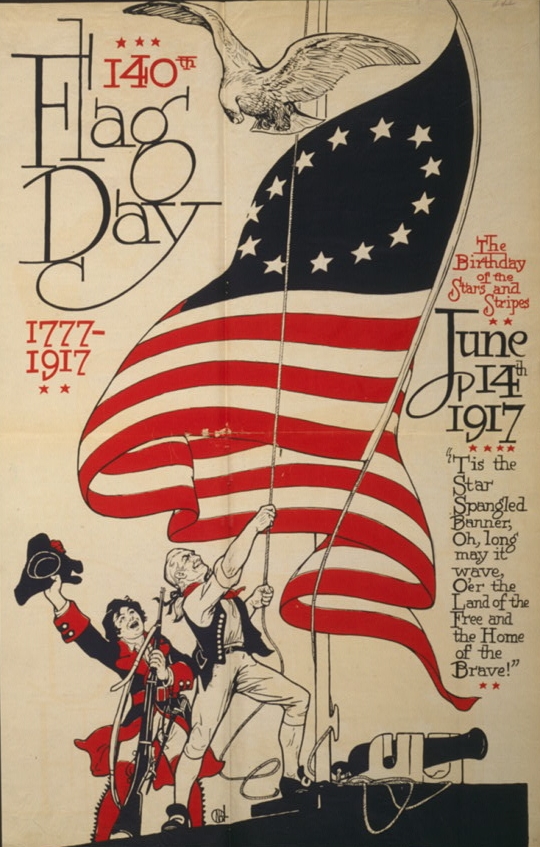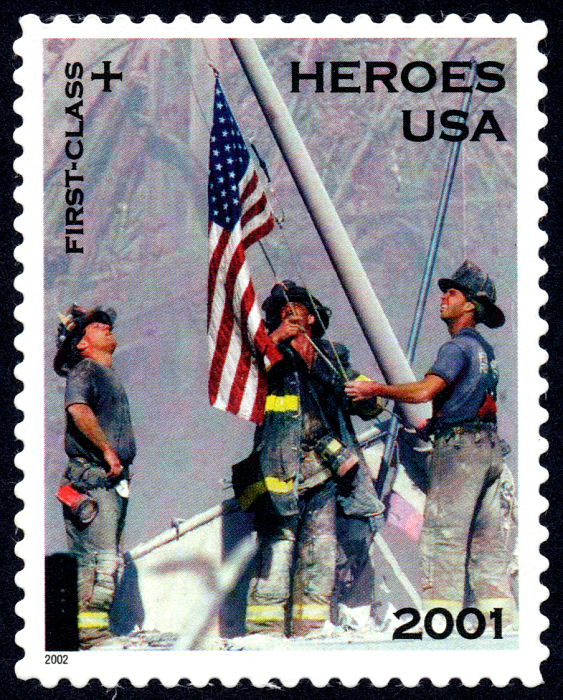The Day of the Flag

Poster commemorating the 140th Flag Day on June 14, 1917 Wikipedia
The U.S. Flag is arguably our Country's most easily identified symbol. The flag itself has evolved and changed its meaning over the course of our 250 years as a country, but what do you really know about it's history?
EVOLUTION OF THE US FLAG
When the United States Flag was first recognized by Congress in 1777, it did not have the familiar thirteen stripes and fifty stars that it does today. Although still red, white, and blue, the Flag had thirteen stars and stripes to represent the original thirteen colonies of the United States. Since the United States’ independence, the national Flag has been revised twenty-seven different times.
The most common revision is the adding of additional stars each time a state (or states) was added to the union. The most recent version of the Flag was recognized in 1960 when Hawaii became a state. Although the design of the US Flag was altered – and may continue to alter – if states are added, the red, white, and blue remains unchanged.
Sorry, Betsy
While you may not know his name, a congressman, a patriot, lawyer, poet, artist, and signer of the Declaration of Independence from New Jersey is credited by most historians as the rightful designer of the flag. This man is Francis Hopkinson. And in truly American fashion, we know about his work mostly due to documents surrounding the recognition and payment (or lack of it) for his efforts.
Back in 1776, Hopkinson was appointed to the Continental Navy Board, allowing him to devote some of his attention to designing a flag for the fledgling country.
By 1777, the Revolutionary War was in full swing, with no indications of ending quickly. Morale was low, and casualties were high. To show unity with the Continental Army, and in order to establish an official flag for the new nation, the Continental Congress passed the first Flag Act on June 14, 1777. This act set forth the model of the American flag: “Resolved, That the flag of the United States be made of thirteen stripes, alternate red and white; that the union be thirteen stars, white in a blue field, representing a new Constellation.”
So who was Betsy? Betsy, was a seamstress who lived in Philadelphia. According to legend, George Washington employed Betsy to embroider his shirt ruffles. The legend says that General Washington gave her a sketch of the flag, and Betsy decided that the stars should have 5 points, not six.
The story of Betsy Ross, and the creation of the flag, are known by most Americans. Historians, however, have another viewpoint of the story. Even after numerous and vigorous searches through diaries, letters, and journals of the Continental Congress, no record exists of a flag being discussed around this time, with Betsy or anyone else. While many Americans still believe that Betsy Ross was responsible for the first American flag, and while it makes for a nice story, sadly, it is most likely false. Or is it...?
Written records do show that in 1780, four years after the Declaration of Independence was signed, Hopkinson requested payment from the Board of Admiralty, requesting payment in exchange for his design of “the flag of the United States of America.”
He submitted a bill, suggesting that a “Quarter Cask of the public wine” would be a reasonable reward for his work. The claim would be refused, and the Board of Treasury would reject the request several times.
.png)
The Great Seal of the United States c. 1899
Because Hopkinson earned a high salary, the Board of Treasury felt that Hopkinson owed a service to the public, and the design was his way of paying that debt.
Interestingly enough, Hopkinson aided in the design of another iconic emblem - The Great Seal of the United States. His sketches included a shield with 13 stripes, 13 stars, and an olive branch, which were later incorporated into the final design.
Long May She Wave!
Flag Day is celebrated in America on June 14, commemorating the day the first flag resolution was passed. The first national observance of Flag Day was on June 14, 1877; 100 years after the flag resolution was adopted by the Continental Congress.
In the late 19th century, schoolteachers all over the United States began conducting patriotic ceremonies commemorating Flag Day as a way to teach children about history. One such schoolteacher, Bernard J. Cigrand, is often referred to as the “Father of Flag Day.” He lobbied Congress for many years for Flag Day to be officially observed. It wasn't until 1949 that it was made official by an Act of Congress.
Back to Betsy
To be fair to Miss Ross, her family stands by the well know story, and there are indications that there may be some truth to the legend. Her uncle George was a member of the original Flag Committee; there are documents that show she had done other seamstress work for General Washington; she is also known to have sewn flags for over 50 years–many well documented from government contracts and receipts.
But perhaps, strongest of all - On May 29, 1777, Betsy Ross was paid a large sum of money from the Pennsylvania State Navy Board for making flags, and about two weeks later, on June 14, 1777, Congress adopted the Stars and Stripes as our official national flag. Coincidence?
A Bit More…
-
THE STAR SPANGLED BANNER
A young lawyer by the name of Francis Scott Key was on a nearby truce ship when he witnessed the attack on Fort McHenry. Although there was great despair over this defeat, Francis Scott Key, and many in his company, found the American Flag still intact. He was so overcome by this symbol of hope that he penned the Star-Spangled Banner.
-
PLAY BALL
It was the World Series of 1918 that a band played the Star-Spangled Banner during the seventh inning of game one. The crowd, standing with their hands over their hearts, sang in unison. This marked the beginning of a tradition that is still held to this day.
-
IWO JIMA
Perhaps the most famous memorial to the Armed Services and the Flag. The capture of Iwo Jima is one of the most recognized events of World War II. The infamous photograph taken by Joe Rosenthal of the Associated Press was reprinted in thousands of publications. It has come to be regarded in the United States as one of the most recognizable images of World War II, and is the inspiration for the Iwo Jima Monument in Washington.

Image: Smithsonian National Postal Museum
-
GROUND ZERO
9/11. Just hours after the second World Trade Center collapsed, a Flag found in the rubble was raised at Ground Zero by three firefighters. The act was captured by Thomas Franklin and remains one of the most prominent photographs in American history.
Content used in this article can be found at: constitutioncenter.org; historicphiladelphia.org; wikipedia.org; nationalflagfoundation.org; postalmuseum.si.edu;


